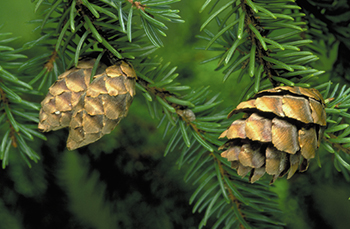Newfoundland and Labrador's provincial symbols
Located in the country’s Atlantic Region, Newfoundland and Labrador is the most easterly province of Canada.
Origin of the name
King Henry VII of England referred to the land discovered by John Cabot in 1497 as the “New Found Launde.”
Population (2006): 509,700
Area: Land – 371,690 km2 Fresh water – 34,030 km2 Total – 405,720 km2 Capital: St. John's Date of entry into Confederation: March 31, 1949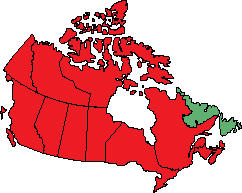
History
The Aboriginal inhabitants of Newfoundland and Labrador were the Beothuk. Archaeological evidence suggests that the Beothuk inhabited Newfoundland long before European colonization and that they may have been descended from earlier people who occupied the island for several thousand years.
At the time of European contact, the Beothuk occupied at least the south and northeast coasts of Newfoundland, numbering perhaps no more than 500 to 1,000 people. By the early 1800s, disease and conflicts with settlers and others frequenting the island led to their extinction.
There were, and still are, a relatively large number of Inuit concentrated in the coastal communities of Northern Labrador.
The first Europeans to visit Newfoundland were Norsemen who are thought to have arrived in the 10th century. Other early visitors – the Basques, Portuguese, Spanish, British and French – staged fishing expeditions in the 16th century and possibly earlier.
The Genoese navigator Giovanni Caboto, known as John Cabot, landed on the island on June 24, 1497, on the feast of St. John the Baptist. Cabot called the new land “St. John's Isle” in honour of the saint.
In 1583, Sir Humphrey Gilbert reasserted England’s claim to the Island of Newfoundland and the surrounding seas for Queen Elizabeth I.
In 1610, a group of merchants under King James I tried to establish a permanent settlement at what is now Cupids on the coast of Conception Bay. This was the first recorded attempt to establish a formal English colony in present-day Canada.
Anglo-French colonial warfare shaped the history of the province during the 17th and 18th centuries. France, already well-established on the mainland of Eastern Canada, began to make claims to parts of Newfoundland. In 1662, France established a fort and colony at Placentia, despite protests from British merchants and fishermen. The Treaty of Utrecht in 1713 ended a long period of raids and confrontations by both nations; it also reconfirmed British sovereignty over Newfoundland and the fishing banks.
The Seven Years’ War (1756–1763) saw a resurgence in hostilities between England and France. However, with the signing of the Treaty of Paris in 1763, British sovereignty was again recognized.
In 1832, the people of Newfoundland were granted the right to vote for an elected assembly. However, conflict between the assembly and the appointed council led to the collapse of the colonial government by 1841. In 1847, the British government decided to revert to a separate assembly and council, although the council was not made responsible to the assembly for its actions. After much debate, Newfoundland was finally given responsible government in 1855.
Newfoundland sent observers to the Québec Conference in 1864, but postponed its decision on whether or not to join the Union. Confederation became the major issue in the general election in Newfoundland in 1869, but the concept did not gain popular approval.
By 1933, the Great Depression, combined with other factors, brought the Newfoundland government close to bankruptcy. Newfoundland, a dominion within the Commonwealth, asked the British government to suspend the legislature. A governor and a six-member Commission of Government ruled Newfoundland from 1934 to 1949.
After World War II, the question of Newfoundland’s future status became an issue once again. In 1948, a public referendum was held on two options: retention of the Commission of Government or a return to the 1934 status as a dominion within the Commonwealth. However, a vigorous popular movement forced British authorities to include a third referendum option: union with Canada.
Following two referenda, confederation with Canada won with 52 percent of the vote. On March 31, 1949, Newfoundland became the tenth province of Canada. In December 2001, the province of Newfoundland became officially the province of Newfoundland and Labrador following the adoption of an amendment to the Constitution of Canada.
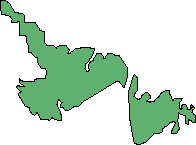
Coat of arms
Newfoundland and Labrador’s coat of arms was granted by King Charles I in 1637. It is one of the oldest of any province or territory.
In commemoration of Cabot’s discovery of the island on the feast of St. John the Baptist, the shield is divided into four parts by a silver cross similar to the cross on the Arms of the Knights of St. John. Two of the four quarters display lions and two display unicorns. These represent the supporters of the Royal Arms after the union of England and Scotland.
Two Aboriginal men in warlike clothing, representing the island’s original inhabitants, support the shield.
The elk in the crest above the shield is included as an example of the fauna of Newfoundland and Labrador. However, the elk has never been native to the province; it is possible that the animal was meant to be a caribou.

Motto
Quaerite prime regnum dei (Seek ye first the kingdom of God)
Flag
Newfoundland and Labrador’s flag, designed by artist Christopher Pratt, was adopted by the provincial legislature in 1980.
Its white area symbolizes snow and ice; blue, the sea; red, human effort; and gold, confidence in the future. The image of the trident (three-pronged spear) on the left side of the flag emphasizes the province’s dependence on fishing and the sea. The two red triangles on the right stand for the mainland and island parts of the province, and the golden arrow represents hope for the future. When the flag is hung as a banner, the arrow assumes the aspect of a sword, a reminder of the sacrifices made in war. The flag’s proportions are two by length and one by width.
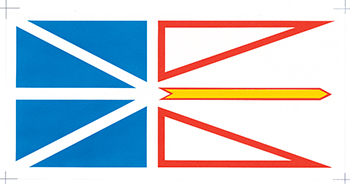
Floral emblem
The insect-eating pitcher plant (Sarracenia purpurea L.) was adopted as Newfoundland and Labrador’s floral emblem in 1954. It is the most unusual of Canada’s official flowers. It was first chosen as a symbol of Newfoundland by Queen Victoria, to be engraved on the newly-minted Newfoundland penny. It was used on the island's coinage until 1938.
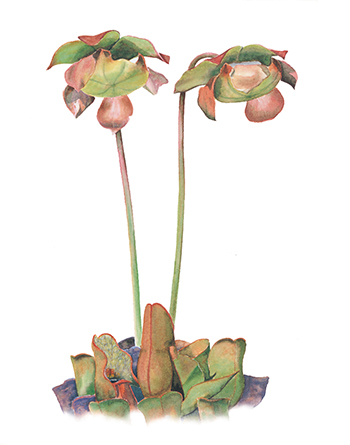
Other provincial symbols
Animals
The Newfoundland dog and Newfoundland pony are well-known symbols of the province of Newfoundland and Labrador.
The Newfoundland dog is famed for its bravery, gentle temperament and strong swimming abilities. It has a stiff, oily outer coat and a fleecy undercoat that allows it to adapt to harsh, wet conditions. Because of their physique, Newfoundland dogs were frequent companions aboard fishing vessels, where they helped to haul nets, and retrieve objects and persons from the water. Because of their size and their life-saving instincts, they can easily pull drowning persons to safety. Their lung capacity enables them to swim long distances while fighting powerful ocean currents.
Newfoundland dogs have proven to be useful on land as well. Capable of pulling heavy loads, they were historically hitched to carts loaded with fish, milk and mail.
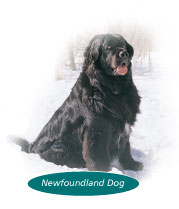
Newfoundland ponies are likely derived from breeds brought from Europe in the early 17th century. Well adapted to the province’s harsh climate and conditions, the ponies were used to haul boats out of the water, pull logs from the forest and prepare land for spring planting. They are quiet animals with good temperaments, good workers, easy keepers and great family pets.
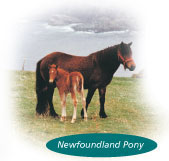
Bird
The Atlantic puffin (Fratercula arctica) is a well-known symbol of Newfoundland and Labrador. Over 95 percent of all the puffins in North America breed on the coasts of the province. The largest colony can be seen in the Witless Bay Ecological Reserve, south of St. John’s.
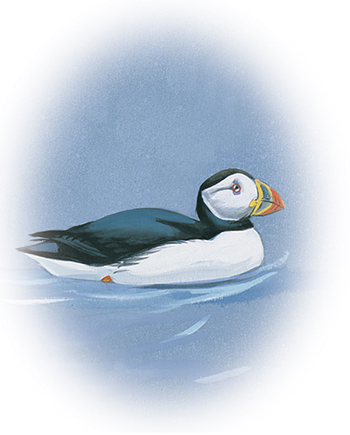
Game bird
The partridge (Lagopus sp) or ptarmigan is the provincial game bird. Two partridge species – the Willow Ptarmigan and the Rock Ptarmigan – are found throughout the province.
Found primarily in barrens and high country, the partridge embodies the open wilderness. An arctic bird, it is speculated that the Burin and Avalon peninsulas may be the most southern, naturally occurring extremity for the bird’s range in North America.
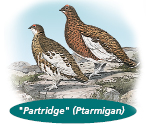
Gemstone
The mineral labradorite is one of the most beautiful and popular of the semiprecious stones and is often used in jewellery and ornaments. Named after Labrador, it is found in abundance near the community of Nain and elsewhere in Labrador as well as on the island of Newfoundland.
Labradorite is usually dark grey, but in the right angle of light, it displays a play of colours mainly in shades of blue and green, but sometimes in yellow, red, and gold. This shimmering effect has nothing to do with surface colour. It is due to internal reflection, and the colours vary depending on the angle of light.

Tartan
The Newfoundland and Labrador tartan was designed by St. John’s Sam Wilansky in the early 1960s. The tartan has the colours of gold, white, brown and red on a green background. The gold represents the sun’s rays; the green, the pine-clad hills; the white, the cloak of snow; the brown, the Iron Isle; and the red, the Royal StandardFootnote 1 for which our fathers stood.
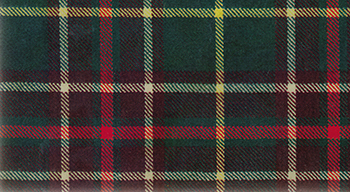
Tree
The black spruce (Picea mariana), also known as the bog spruce, was designated the provincial tree in 1993. Although its foliage is bluish-green, it is called the “black” spruce to distinguish it from other types of spruce trees. It is the most abundant tree in Labrador and appears on the Labrador flag.
